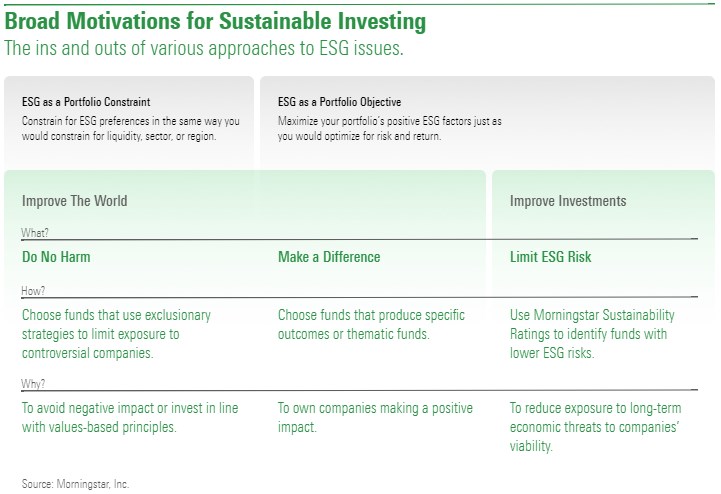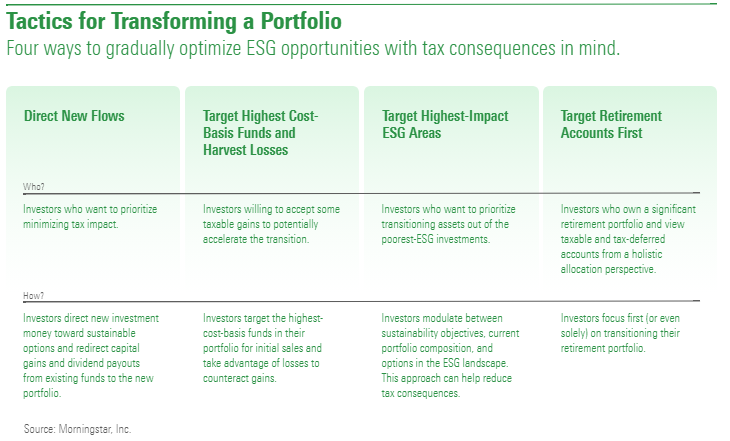
Investors who want to contribute to a more equitable society, address climate-related concerns, or know which companies are effectively managing economic risks face a practical challenge: where to begin.
Although sustainable investing has experienced a marked surge in the last decade—inflows to sustainable funds are on track for another record-breaking year.
It’s easy to get lost when building a sustainable portfolio. There are numerous questions to consider: What sustainability goals am I hoping to achieve? How can I pursue these goals while still seeing strong investment returns? What funds are available to add to my portfolio? How can I tell the difference between the sustainable options? And how do I go about transitioning my portfolio to include them?
But it doesn’t have to be complicated.
Investors can use our step-by-step guide to understand how goals around environmental, social, and governance issues can translate into real changes to your investing portfolio.
- Discover what sustainable investing means to you
- Understand what’s in your current portfolio
- Know the sustainable options available to you
- Make a plan to transition your portfolio
If you’re a financial advisor, this guide can help you lead your clients through the transition to more-sustainable investing. You can also explore the original paper in Morningstar Direct.
Step One
Discover What Sustainable Investing Means to You
As with any aspect of financial planning, it’s important to establish goals at the outset. Without an understanding of how you see ESG issues fitting into your portfolio, it’s hard to know what types of changes to make.
We see three levels of ESG awareness among investors:
- ESG unaware: An investor who doesn’t have a base-level concern and, thus, doesn’t use ESG data or preferences to make investment decisions.
- ESG aware: An investor who’s mindful of ESG issues and considers ESG risk as part of their regular investment process.
- ESG motivated: An investor who seeks to maximize the use of ESG data to achieve an optimal trade-off between ESG scores, risk, and return, as noted in a 2020 article for the Journal of Financial Economics by Lasse Pedersen, Shaun Fitzgibbons, and Lukasz Pomorski.
If you’re a highly motivated ESG investor, there may be more to unpack around your specific preferences and interests.
You might be specifically concerned about the economic impact of climate change on a company’s financial viability. In addition to profits, maybe you want to place more weight on how your investments impact people or the planet. Maybe you have specific thematic interests within those components and want to focus solely on eliminating manufacturers of guns and cigarettes from your portfolio or emphasizing companies that facilitate sustainable environmental practices.
Then there’s the question of how to engage in impact investing. Do you want to invest in companies seeking to make a measurable, positive impact on the environment or society? Those investment options could include, among other things, clean-energy firms and green bonds.
Finally, for investors who come to this process with a general desire to do something more sustainable in their investment portfolio, they need to decide where to focus their energies. Here, an advisor can play a role in identifying and putting an investor’s interest into practice.
Uncover Your Motivations for Sustainable Investing
Investors and institutions can be driven by a desire to improve the world (that is, generate positive environmental and societal outcomes) or a desire to improve investments, but most often it is a blend of both.
Investors who want to improve the world can aim to Do No Harm, meaning they avoid negative impact, or to Make a Difference, meaning they seek positive impact. Investors who believe ESG risks present economic threats to companies’ long-term viability can aim to Limit ESG Risk.
Of course, these categories are not mutually exclusive; many investors may overlap. See below what these approaches look like and how they differ from one another.

You can also use a more detailed questionnaire or worksheet to uncover which of these approaches is right for you.
A final question to consider when setting ESG goals is whether these issues should be viewed as a portfolio objective or a portfolio constraint. The table above shows how these options line up with the various types of sustainable investing.
To include sustainability as a portfolio objective, you could seek to maximize your portfolio’s positive ESG factors just as you would optimize for risk and return. You could also factor in ESG risk as part of your total risk expectations. This approach might work well for a highly motivated ESG investor with a relatively diffuse ESG focus.
Conversely, you can use sustainable investing as a portfolio constraint. For example, you could exclude any funds that are exposed to weapons manufacturers or minimize the overall level of carbon risk in your portfolio.
Step Two
Understand What’s in Your Current Portfolio
The next step is to look at the sustainability of your current portfolio.
To determine your sustainability profile and how much of your portfolio may need to be reallocated, you can ask these questions:
- Intentional attributes: Do I prefer a fund that pursues ESG goals by design, or will I also accept funds that have unintentionally strong ESG qualities? What percentage of my portfolio meets these criteria, and in what asset classes are those funds?
- ESG risk: How well is a company managing its financially material ESG risks relative to industry peers?
- ESG commitment level: How much of my portfolio is devoted to funds run by managers highly committed to ESG processes? And how does this fit or not fit with the level of ESG risk?
- Climate impact: Do the holdings of funds in my portfolio align with my low-carbon objectives? (This is most relevant to investors who have a specific interest in minimizing climate impact.)
Determining risk and exposure is complicated. It is important for investors and advisors to review all these factors collectively, not just as independent parts, to ensure a complete understanding of the portfolio.
Morningstar Direct provides a range of tools and data points that can help you answer these questions and start thinking about potential reallocation decisions.
Step Three
Know the Sustainable Options Available to You
Now that you’ve identified your individual priorities and dissected the sustainability of your portfolio, it’s time to start making changes.
We’ll dig into the most popular approaches to sustainable investing, and the pros and cons of each.
If You Want to Eliminate the Bad: Exclusionary Screening
Most, though not all, sustainable funds employ some level of exclusions in determining the investable universe. Common exclusions include gambling, alcohol, pornography, civilian weapons manufacturing, tobacco, and fossil fuels.
There are a few reasons funds may employ exclusions:
- A specific set of morals or ethics is often behind the exclusions of socially responsible, faith-based, and values-based investing strategies, such as Catholic funds or Shariah-compliant funds. These funds frequently use screens against gambling, alcohol, and pornography.
- Financial materiality means that funds employ exclusions because of the financial prospects of a sector or business category, rather than a set of morals. For example, some fund managers choose to screen out the energy sector because they expect businesses in that sector to be economically challenged in the future.
- Regulatory environments can also drive exclusions. Funds distributed in the European Union, for example, are prohibited from investing in companies that derive more than 25% of revenue from the production of civilian weapons.
- These negative screens have historically been a common argument against sustainable investing because, by deliberately limiting the investable universe, a manager may be limiting the fund’s potential for outperformance. But exclusions surface in all strategy types: Even funds that don’t pursue ESG strategies exclude companies that don’t align with their mandate or strategy. Consider that value equity managers screen out expensive companies and growth managers exclude slow-growing companies.
- Once an exclusion is implemented, a portfolio will tilt toward one style or another. Thus, managers will take care to monitor the portfolios’ exposures to certain factors, industries, and sectors, and offset any adverse effects of the exclusion.
If You Want to Emphasize the Good: Active Equity Funds
Funds could also choose to actively bring good companies into their portfolio rather than only avoiding problematic ones. Of all asset classes, actively managed equity funds—that is, equity funds where the portfolio manager seeks to beat the overall stock market—have the most opportunities for making ESG considerations part of their investment process.
This commonly begins with a narrowing of the investable universe by screening out controversial businesses. From there, the portfolio managers select securities, typically based on a combination of financial prospects and fundamental sustainability research (both proprietary and third-party).
Then, holdings are optimized according to various objectives, including sustainability criteria. To do so, fund managers will typically allocate a greater portion of the portfolio to the most impressive securities from an ESG perspective.
If You Take a More Hands-off Approach: Passive Funds
Where active managers seek to outperform the market benchmark, passive managers use a rules-based approach that seeks to deliver returns on par with the broad market.
But the inclusion of ESG data makes passive investing even more difficult. Unlike market-cap-weighted stock indexes, there’s no market standard for sustainable indexes. Rather, different index providers will have different views on ESG data.
If You Want to Pursue Impact Investing: Fixed-Income Funds
Sustainable fixed-income funds tend to face greater challenges than their equity peers for many reasons, but there are two main ones:
- By and large, it is more complex to develop a framework for evaluating sustainability in debt instruments than for equities because of different disclosure requirements for companies issuing debt.
- Sustainability-challenged sectors—such as energy—tend to take up larger positions in bond benchmarks than they do in most equity benchmarks. Any high-yield ESG bond fund that screened out these prominent sectors would perform quite differently from its benchmark and peers—making it hard for many advisors to recommend.
That said, there is one area where fixed-income funds hold a significant advantage over equity funds: impact investing. Unlike equity instruments, debt securities can be earmarked for specific projects and initiatives, more directly linking an investor’s capital to sustainable outcomes.
Step Four
Make a Plan to Transition Your Portfolio
Once you’ve determined the types of sustainable investing strategies you’re interested in, it’s time to start transitioning your portfolio.
Keep in mind several different—sometimes competing—factors during this process, such as:
- Your ESG goals and level of intensity and engagement regarding them.
- The ESG profile of the existing portfolio.
- The opportunity set of available sustainable investing strategies.
- Your overall risk and return objectives.
- The tax consequences of any reallocation of capital.
How Quickly Should You Transition Your Portfolio?
Given the behavioral and tax implications of quickly moving a portfolio into the target allocations, we urge taking a gradual approach to transitioning your assets.
However, there might be some situations in which to consider the “going big” strategy:
- For investors whose assets are primarily in tax-deferred retirement accounts, a radical transformation wouldn’t trigger any dramatic tax consequences.
- For younger or newer investors, they might have a sufficiently low tax basis in their investments to make fund changes less onerous from a tax perspective.
- For investors who are passionate enough about their ESG goals, it might be worth it to absorb the tax consequences of such a move. Of course, no matter how ardently one feels about ESG-related issues, this might not be possible if the investor is not able to withstand greater immediate tax payments.
Still, these are likely to be limited situations. And in any of them, you should closely evaluate your entire financial and tax situation, along with the costs and benefits of paying early capital gains taxes on fund sales, before deciding to do so. In most cases, a more gradual approach will make more sense. The table below details several ways that different kinds of investors can transition their portfolio.

The right tactic for you will depend on several factors, such as what you consider a priority and if you have the financial wherewithal to offset larger-than-usual taxes.
For example, if your top priority is reducing the carbon-emissions footprint of the portfolio, you might try targeting highest-impact ESG areas to prioritize withdrawing assets from equity funds with high carbon risk scores and transitioning them to funds that earn a Low Carbon Designation.
And if your portfolio meets the requirements, targeting retirement accounts first might be appealing because of its potential for large impact more quickly. But because of these specific conditions, it may not be tenable for all investors, and you’ll still have to bear in mind the limitations of the available universe.
The Long and Rewarding Road to a Sustainable Portfolio
This framework isn’t designed to be prescriptive, but to illustrate a flexible set of steps that you can take to meet your sustainability preferences, goals, and needs.
We expect investment options and data points related to sustainability to change rapidly in the coming years. Yet amid existing complexities and limitations, there are many available paths you can take to improve a portfolio’s ESG-friendly qualities, while maintaining comparable investment quality and diversification.




















